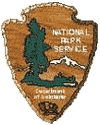
Galloping Over the Graves of Their Ancestors
by Ted Fremd

Modern horses fascinate people around the world. Their speed, endurance, intelligence, and behaviors seem to suggest that they represent some sort of apex of evolution or an example of a perfectly adapted species. Actually, the horses that are alive today (belonging to six species, many nearly extinct) are mere leftovers from what was a much more diverse and successful family of animals, when dozens of species co-existed.
Back in the 1870's, many interesting horse fossils were collected from the John Day Basin and shipped to museums on the East Coast. These became the basis, along with specimens from other locations, of one of the classic "lineages" that has been used as an example of evolution in museums and textbooks ever since. In fact, the horse fossils from the John Day were critical for piecing together evidence demonstrating the first geological lineage of any animals. The pattern of change through time is remarkably complex, but some general trends emerge in comparing early horse ancestors to the modern horses (including zebras, onagers, and asses).
As we look at fossil horses from old to progressively younger strata, they generally get much larger, the legs are lengthened (especially the feet), the side toes are reduced, and the middle toe gets much bigger. There is a pronounced straightening and stiffening of the back. The incisors get wider, the cheek teeth begin to get very large and similar to one another, the tooth crowns get taller, and the enamel pattern gets much more complicated. The face gets long, and the height of the skull and jaw gets deep. There is also an increase in the size and complexity of the brain.

We can go out to the rocks around here today and, with skill, patience, and luck put together a good fossil horse collection to illustrate these trends. From the 40 million year old rocks southwest of Fossil, we can find some little specimens, some of the oldest members of the family. At Sheep Rock, there are abundant little three-toed horses found in 25 million year old strata. Just West of Dayville are found some deer-sized horses in rocks deposited 15 million years ago, and in the rocks from Mount Vernon to Dayville can be found rocks half as old as these, with horses that look more like modern kinds.
As George Gaylord Simpson once noted, "It is evolution that gives rhyme and reason to the story of the horse family as it exists today and as it existed in the past. Our own existence has the same rhyme and reason, and so has the existence of every other living organism. One of the main points of interest in the horse family is that it so clearly demonstrates this tremendously important fact."
Ironically, horses went extinct in their ancestral home of North America over 10,000 years ago. They were just reintroduced by humans in this millennium.
The FOSSIL RECORD is a monthly column written by the paleontologist at John Day Fossil Beds for local newspapers in Eastern Oregon...
fossil-record/6.htm
Publication Date: 4/11/1998